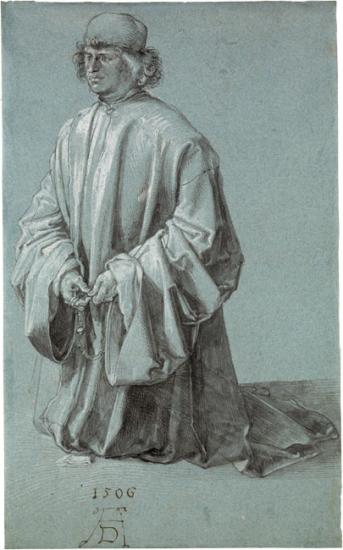
Kneeling Donor, 1506
Signed with the artist's monogram and dated, at lower left, in brown ink, 1506.
Purchased by Pierpont Morgan, 1910
Dürer's interest in proportion and portraiture unite in this religious subject. This study is for one of his most prestigious commissions, the Feast of the Rose Garlands, an altarpiece now in the National Gallery, Prague. Created for the German Confraternity of the Rosary in Venice, it originally stood in the church of San Bartolomeo. While this figure corresponds to one of the donors flanking the Virgin and Child in the painting, the drawing is not merely a preparatory sketch but a highly finished work of art. Dürer chose a rich blue paper—the Venetian carta azzurra that he adopted during his 1505–7 sojourn in Italy—and used black and white heightening to achieve a full range of tonal effects.
During his sojourn in Venice from 1505 to 1507, Dürer received the important commission to paint The Feast of the Rose Garlands for the German Confraternity of the Rosary. It was to hang in their national church, San Bartolomeo, prominently located near the Rialto.
The drawing is a study for one of the principal donors in the painting—possibly a member of the Fugger family—seen holding a rosary and kneeling in the right foreground. It is drawn with the point of the brush on blue paper, a technique that had become customary among Venetian painters during the late fifteenth century.
Travel and the Venetian Empire
By 1500 Venice was the foremost maritime power in Europe as well as an international cultural destination. The city's empire included a dense web of fortified harbors in the eastern Mediterranean stretching along the Dalmatian coast to Crete and Cyprus, which protected its trading interests. In order to cater to the needs of its merchants and naval commanders, Venice became an important center of cartography.
The city's wealth and stability fostered artistic creativity and attracted a host of influential foreign artists, such as Albrecht Dürer, Andrea Schiavone, and El Greco. Not only did these visiting artists invigorate the city's artistic life, they also spread Venetian innovations far beyond the territorial confines of the empire.
